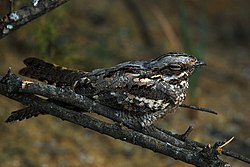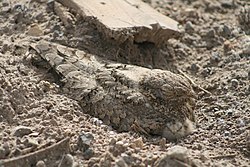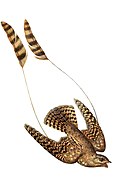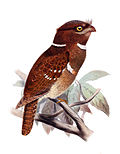Caprimulgus
| Caprimulgus | |
|---|---|

| |
| Large-tailed nightjar (Caprimulgus macrurus) | |
| Scientific classification | |
| Kingdom: | Animalia |
| Phylum: | Chordata |
| Class: | Aves |
| Clade: | Strisores |
| Order: | Caprimulgiformes |
| Family: | Caprimulgidae |
| Genus: | Caprimulgus Linnaeus, 1758 |
| Type species | |
| Caprimulgus europaeus (European nightjar) Linnaeus, 1758
| |
| Species | |
|
39, see text. | |
| Synonyms | |
|
Stenopsis | |
Caprimulgus is a large and very widespread genus of nightjars, medium-sized nocturnal birds with long pointed wings, short legs and short bills. Caprimulgus is derived from the Latin capra, "nanny goat", and mulgere, "to milk", referring to an old myth that nightjars suck milk from goats. The common name "nightjar", first recorded in 1630, refers to the nocturnal habits of the bird, the second part of the name deriving from the distinctive churring song.[1]
Caprimulgus nightjars are found around Afro-Eurasia and Australasia, and like other nightjars they usually nest on the ground. They are mostly active in the late evening and early morning or at night, and feed predominantly on moths and other large flying insects.
Most have small feet, of little use for walking, and their soft plumage is cryptically coloured to resemble bark or leaves. Some species, unusually for birds, perch along a branch, rather than across it, which helps to conceal them during the day. Temperate species are strongly migratory, wintering in the tropics.
Caprimulgus species have relatively long bills and rictal bristles. Many have repetitive and often mechanical songs.
Taxonomy
[edit]The genus Caprimulgus was introduced in 1758 by the Swedish naturalist Carl Linnaeus in the tenth edition of his Systema Naturae.[2] The type species is the European nightjar (Caprimulgus europaeus).[3] The name is the Latin word for a nightjar; it combines capra meaning "nanny goat" and mulgere meaning "to milk".[4] The myth that nightjars suck milk from goats is recounted by Pliny the Elder in his Natural History: "Those called goat-suckers, which resemble a rather large blackbird, are night thieves. They enter the shepherds' stalls and fly to the goats' udders in order to suck their milk, which injures the udder and makes it perish, and the goats they have milked in this way gradually go blind."[5]
Species
[edit]The genus contains 39 species.[6]
| Image | Scientific name | Common Name | Distribution |
|---|---|---|---|
 |
Caprimulgus ruficollis | Red-necked nightjar | western Mediterranean |
 |
Caprimulgus indicus | Jungle nightjar | India and Sri Lanka |
 |
Caprimulgus jotaka | Grey nightjar | East Asia and Himalayas ; winters to Southeast Asia |
| - | Caprimulgus phalaena | Palau nightjar | Palau |
 |
Caprimulgus europaeus | European nightjar | western palearctic ; winters to Sub-Saharan Africa |
 |
Caprimulgus fraenatus | Sombre nightjar | East Africa |
 |
Caprimulgus rufigena | Rufous-cheeked nightjar | southern Africa |
 |
Caprimulgus aegyptius | Egyptian nightjar | Morocco to Sudan and southern Kazakhstan |
 |
Caprimulgus mahrattensis | Sykes's nightjar | Pakistan, southern Afghanistan and Iran ; winters to India |
 |
Caprimulgus nubicus | Nubian nightjar | Red Sea area and Horn of Africa |
 |
Caprimulgus eximius | Golden nightjar | Sahel |
 |
Caprimulgus atripennis | Jerdon's nightjar | southern India and Sri Lanka |
 |
Caprimulgus macrurus | Large-tailed nightjar | northern Pakistan though Southeast Asia to Queensland and New Guinea |
 |
Caprimulgus meesi | Mees's nightjar | Flores and Sumba |
| - | Caprimulgus ritae | Timor nightjar | eastern Lesser Sundas |
 |
Caprimulgus andamanicus | Andaman nightjar | Andaman Islands |
 |
Caprimulgus manillensis | Philippine nightjar | Philippines |
| - | Caprimulgus celebensis | Sulawesi nightjar | Sulawesi and Sula Islands |
 |
Caprimulgus donaldsoni | Donaldson Smith's nightjar | Horn of Africa to northern Tanzania |
 |
Caprimulgus pectoralis | Fiery-necked nightjar | Sub-Saharan Africa |
 |
Caprimulgus poliocephalus | Montane nightjar | eastern Afromontane |
 |
Caprimulgus asiaticus | Indian nightjar | South Asia to southern Indochina |
 |
Caprimulgus madagascariensis | Madagascar nightjar | Seychelles and Madagascar |
 |
Caprimulgus natalensis | Swamp nightjar | sparsely across Sub-Saharan Africa |
 |
Caprimulgus solala | Nechisar nightjar | Nechisar Plains, Ethiopia |
 |
Caprimulgus inornatus | Plain nightjar | northern Sub-Saharan Africa and southwestern Arabia ; winters to more southern latitudes |
 |
Caprimulgus stellatus | Star-spotted nightjar | Ethiopia, northern Kenya and southern South Sudan |
 |
Caprimulgus affinis | Savanna nightjar | Indomalaya |
 |
Caprimulgus griseatus | Chirruping nightjar | Philippines |
 |
Caprimulgus tristigma | Freckled nightjar | Sub-Saharan Africa |
| - | Caprimulgus concretus | Bonaparte's nightjar | Sumatra and Borneo |
| - | Caprimulgus pulchellus | Salvadori's nightjar | montane Sumatra and Java |
| - | Caprimulgus prigoginei | Prigogine's nightjar | Itombwe Mountains |
 |
Caprimulgus batesi | Bates's nightjar | Congo Basin |
 |
Caprimulgus climacurus | Long-tailed nightjar | northern Sub-Saharan Africa |
 |
Caprimulgus clarus | Slender-tailed nightjar | East Africa |
 |
Caprimulgus fossii | Square-tailed nightjar | miombo and adjacent areas |
| - | Caprimulgus longipennis | Standard-winged nightjar | forested areas of northern Sub-Saharan Africa |
 |
Caprimulgus vexillarius | Pennant-winged nightjar | miombo ; winters in equatorial latitudes |
References
[edit]- ^ "Nightjar". Oxford English Dictionary (Online ed.). Oxford University Press. (Subscription or participating institution membership required.)
- ^ Linnaeus, Carl (1758). Systema Naturae per regna tria naturae, secundum classes, ordines, genera, species, cum characteribus, differentiis, synonymis, locis (in Latin). Vol. 1 (10th ed.). Holmiae (Stockholm): Laurentii Salvii. p. 193.
- ^ Peters, James Lee, ed. (1940). Check-List of Birds of the World. Vol. 4. Cambridge, Massachusetts: Harvard University Press. p. 196.
- ^ Jobling, James A. (2010). The Helm Dictionary of Scientific Bird Names. London: Christopher Helm. p. 90. ISBN 978-1-4081-2501-4.
- ^ Rachham, H. (1967). Pliny Natural History III Libri VIII-XI. The Loeb Classical Library. Cambridge, Massachusetts: Harvard University Press. pp. 366–367.
- ^ Gill, Frank; Donsker, David; Rasmussen, Pamela, eds. (August 2024). "Frogmouths, Oilbird, potoos, nightjars". IOC World Bird List Version 14.2. International Ornithologists' Union. Retrieved 29 August 2024.






